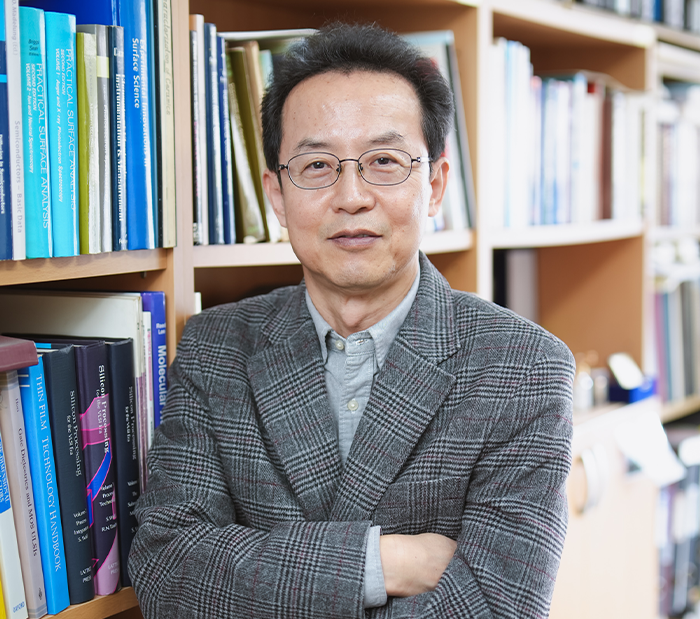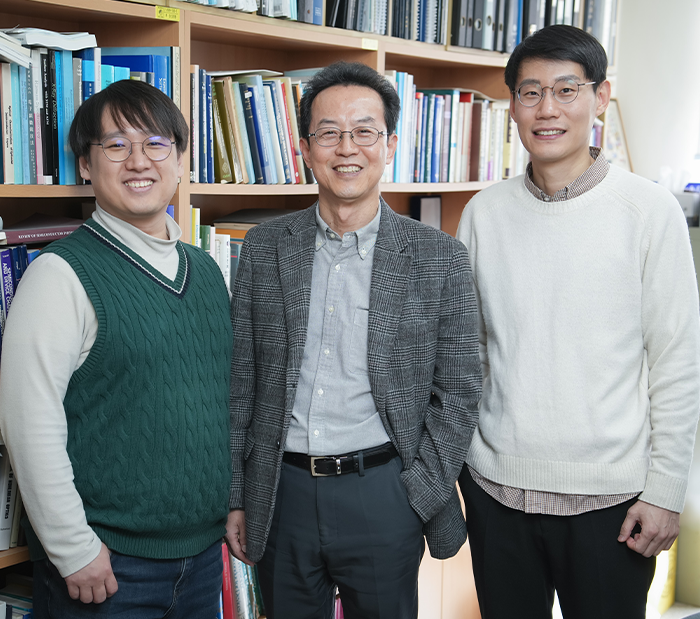Predicting and demonstrating of hidden metastable phase in transition metal oxide
Advanced Materials Science and Engineering LEE, JAICHAN Prof. · Bongwook Chung
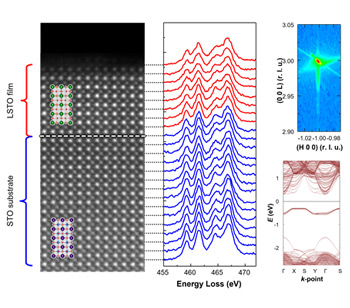
-
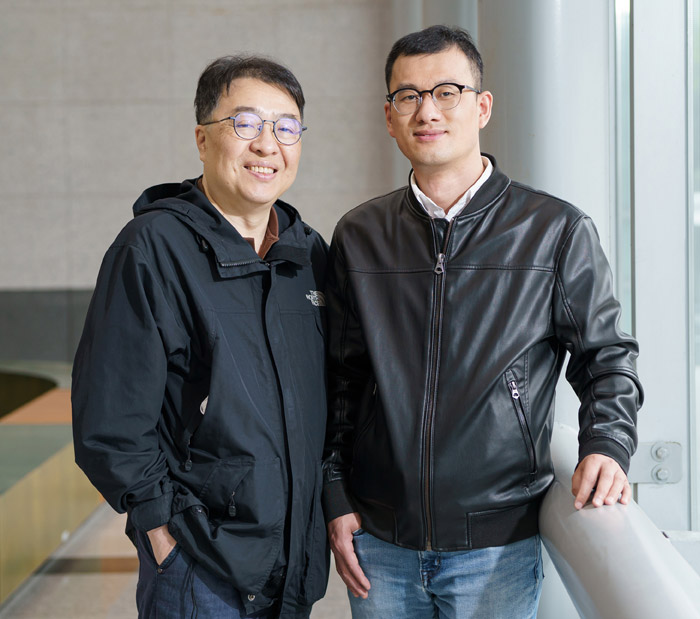
Physics KANG, DAE-JOON Prof. ·Prof. Dong-Hwan Kim · Dr. Yongteng Qian
Prof. Kang Dae Joon (Physics)enhancing output power density of polydimethylsiloxane flexible triboelectric nanogenerator
In collaboration with Professor Dong-Hwan Kim (School of Chemical Engineering), Professor Dae Joon Kang (Department of Physics)'s team has reported a novel approach to increase polydimethylsiloxane-based output power density flexible triboelectric nanogenerators using ultra-thin nickel telluride nanosheets as a co-triboelectric layer. Flexible triboelectric nanogenerators (FTENGs) can harness various mechanical energies such as wind, water flow, and human motion for energy and sensing purposes; therefore, it was in the spotlight. In general, a critical factor that determines the electrical output behavior of FTENGs is the proper selection of active triboelectric materials. Among the many suitable triboelectric materials, polydimethylsiloxane (PDMS) is considered an excellent material for FTENGs due to its good mechanical strength, high flexibility, and excellent electron negativity. However, the output power density of PDMS-based FTENGs remains unsatisfactory. Inorganic materials such as metal sulfides, semiconductingmetal oxides, metal-organic frameworks, and MXenes could be explored as activeco-triboelectric materials in combination with PDMS due to their high chemicalstability, excellent mechanical strength, and high electrical conductivity.Among the many novel inorganic materials, nickel telluride (NiTe2) is considered a promising co-triboelectric material with PDMS due to its goodconductivity, high chemical stability, good mechanical strength, and facilesynthesis. Moreover, highly conductive NiTe2 can effectively lower the internalresistance of PDMS, further improving the output performance of PDMS-basedFTENGs. In addition, the nano-belt (NB) can be considered a promising platformfor designing high-performance energy collection devices due to its uniquemorphological advantages of higher aspect ratio, larger surface area, moreenergy collection sites, and faster charge transfer rate compared to many otherform factors. Therefore, the team used NiTe2 NBs as a co-triboelectric material with PDMS to further improve the output performance of PDMS-based FTENGs. The team systematically investigated their triboelectric performance in terms of the weight ratio of NiTe2 NB to PDMS, the device's size, the thickness of PDMS, and the temperature dependence of their output power. As a result, the optimized PDMS/5% NiTe2 NB FTENGs produced a remarkable output power density of 1.89 mW cm-2 and excellent flexibility. Moreover, these FTENGs with a size of 1 cm2 and 9 cm2 could instantly power 70 and 150 LEDs, respectively, under the periodic vertical force of a human palm tapping. Our results show that NiTe2 NB is an excellent co-triboelectric material with PDMS to achieve high-performance PDMS-based FTENGs. This research was supported by the BK21 Four Program and published in Nano Energy (IF = 17,881), one of the leading journals on nanomaterials and nanodevices for energy harvesting and conversion. Paper title: Enhancing the output power density of polydimethylsiloxane-based flexible triboelectric nanogenerators with ultrathin nickel telluride nanobelts as a co-triboelectric layer
- No. 186
- 2022-04-28
- 2166
-
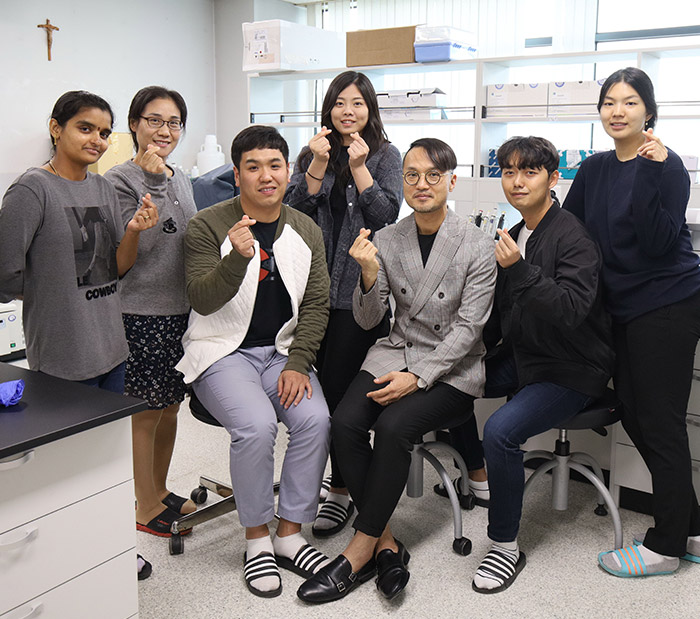
Chemical Engineering UM, SOONG HO Prof. ·So Yeon Ahn, Jeonghun Kim
“In vitro functional protein expression using messenger RNA hydrogel" Professor Soong Ho Um(Chemical Engineering)
On April 5, a research paper titled "Protein-encoding free-standing RNA hydrogel for sub-compartmentalized translation," written by Professor Soong Ho Um in the school of Chemical Engineering, was published online in the Advanced Materials (IF =30.849) as a cover paper in recognition of its excellence. The research study was conducted in collaboration with Progeneer Inc., a domestic bio-venture company, and it is expected to be used in various biopharmaceutical fields such as cytokine for several medical uses and personalized new drugs because of the outstanding advantages of being able to produce large amounts of functional proteins in a short time. The team has created a new messenger RNA hydrogel structure with physiological and chemical functions by applying the rolling circle transcription and regularly arranging nucleic acid quadruple helical structures based on nucleic acid nanotechnology. RNA plays a pivotal role in regulating and expressing biological activity in vivo, but it is unstable and not easy to produce the desired design. In a situation where these serious and essential limitations are pointed out, this study suggests a wise solution. The team’s research has proved that the biological regulator role of natural RNAs, such as enzyme catalyst action and protein synthesis, is possible outside of cells through bio-inspiration. This technology has exactly reproduced the ‘Spatiotemporal RNA-derived RNA phase transformation’ that occurs in the translation process of the central dogma process, the central principle of life, and thus enabled protein mass-production through gel internal compartmentalization. Since the 1950s, by “cell-free protein expression” technology, protein production could be done outside the cell. With the rapid development of the modern biopharmaceutical market, this is receiving global attention. This study has also contributed to significantly maximizing the efficiency, which is a fatal disadvantage of cell-free protein expression technology. Also, the gel form of RNA is made possible for the first time, and the RNA having various functions secures the high mechanical property. This result suggests the possibility of developing new materials equipped with genetic information. The research’s universal applicability, which solves the fundamental issue of RNA and contributes to the central principle of life, is expected to create various applied technology to pioneer in a new area of research. Progeneer CEOs Chul Kim and Young Ku Lee are directly applying the technology to their personalized anti-cancer vaccine project (ProV-001) and achieving a functional protein synthesis pipeline. Journal Cover, using hydrogel only consisted of RNA to mass produce protein with low cost at short period of time [Research Overview] Examples of mass production of functional proteins using RNA hydrogels technology
- No. 185
- 2022-04-19
- 2882
-
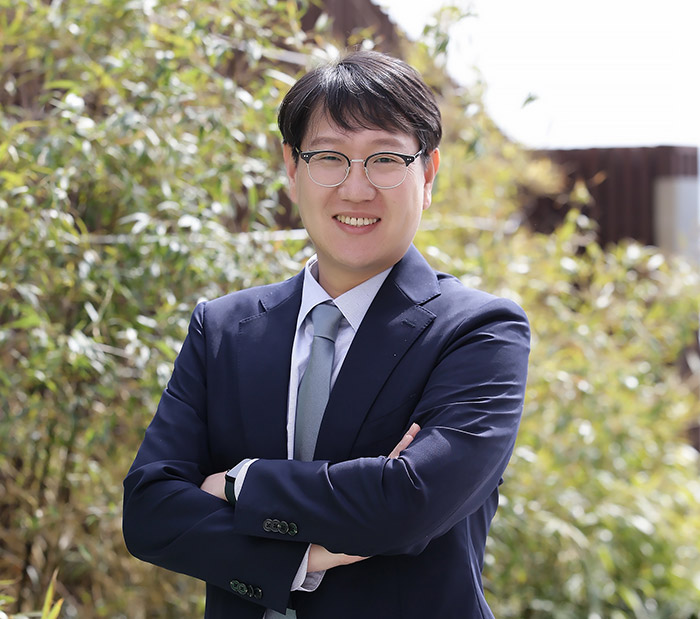
Media & Communication BAEK, TAE HYUN Prof.
Proposal of Social Media donation message strategy in consideration of psychological traits ‘pride and gratitude’
Professor Tae Hyun Baek in the Department of Media and Communication has published hisfirst-author study in the 2022 March issue of the Journal of Business Research(IF = 7.550, Q1 in Business/Marketing Category). He collaborated with ProfessorSukki Yoon at Bryant University. He conducted three experimental studies of prosocial advertising on social media to investigate how self-benefit (e.g., “Make your life more meaningful and earn a taxdeduction by giving your support”) and other person-benefit (e.g., “Help others suffering from hunger and make our community a better place by giving yoursupport”) donation appeals paired with pride and gratitude affect donation amounts and donation intentions. He examined incidental and integral emotion induction procedures and used diverse samples of college students and nonstudent adults. Participants induced to feel pride donatedmore significant amounts (Study 1) and donated more frequently (Studies 2 and3) when they viewed Twitter and Instagram ad messages that focused on thebenefits to donors themselves rather than focus on benefits to others in need.However, self-benefit and other-benefit appeals were equally effective wheninduced to show gratitude. This research contributes to theliterature by identifying pride and gratitude as determining the relativeeffectiveness of self-benefit versus other person-benefit appeals. In addition,to the best of our knowledge, this research is the first to investigate howpositive emotions can be matched explicitly with message appeals to influencedonation amounts and intentions to donate. Practically, the findings of this researchhave the potential to impact social media fundraising advertising strategies.For example, nonprofit organizations advertising on Facebook and Twitter mighthighlight their achievements and then provide individualized congratulatoryemails that make recipients feel proud or grateful. For instance, St. JudeChildren’s Research Hospital could advertise its success in increasing survivalrates through innovative research and then send messages that evoke pride. Likewise,the World Wildlife Fund could promote its success in saving endangered speciesfrom extinction and sending thank you messages that evoke gratitude. Relatedly,charity fundraisers might use social media content to trigger feelings of prideand gratitude through corresponding emotion-laden hashtags (e.g., #proud and#grateful) depending on whether the posting contains egoistic or altruisticmessages.
- No. 184
- 2022-04-11
- 2381
-
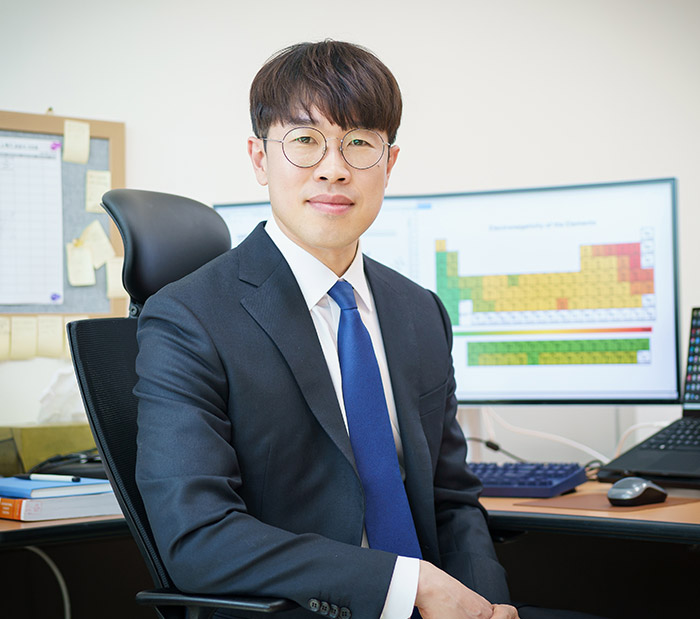
SKKU Advanced Institute of Nano Technology LEE, JIN WOOK Prof. ·Keonwoo Park
Stability-limiting heterointerfaces of perovskite photovoltaics
Prof.Jin-Wook Lee`s research team in the SKKU Advanced Nano Technology (SAINT) and Department of Nano Engineering have successfully developed core technologies to significantly improve the stability of perovskite solar cells (PSCs). The research paper was published in the world-renowned scientific journal Nature on March 15, 2022. The PSCs are considered a promising candidate for next-generation photovoltaictechnology due to their high-efficiency and low manufacturing cost. Recently,many researchers in both academia and industry are working on resolving remaining issues for commercialization of the PSCs such as poor long-termoperational stability. For fabrication of high-performance PSCs, reducing crystal defect density in bulk and surface of the perovskite film is essential. A surface passivation strategy by alkylammonium halides has been widely used to enhance the power conversion efficiency of PSCs. However, incorporation of the insulating passivation layer between perovskite and charge transporting layer can cause charge accumulation at the interface and degrade the PSCs' operational stability. The previous studies have only focused on the efficiency improvement by the surface passivation layer, but they did not notice the possible side effects of thesurface passivation layers. Prof.Lee`s team unraveled that the widely used surface passivation layer distorts energy band structure at the heterointerface of the PSCs to impede photo-generated charge collection, and consequently aggravate the stability ofperovskite solar cells. They developed a new surface passivation agent without the side effects to maximize the PSC’s power conversion efficiency and operational stability. As a result, the PSCs fabricated in their study demonstrated the world's best efficiency and stability. Prof.Lee`s research provides advanced understanding of energy band structure at the heterointerfaces based on halide perovskite, expected to resolve the stability issue of the PSCs to accelerate the commercialization of the PSCs. Meanwhile,Prof. Jin-Wook Lee recently published another review paper on ‘A’ site cationin halide perovskites in Science. He was selected as Highly Cited Researchers 2021 (HCR 2021) by Clarivate Analytics in the field of cross-field. ※ Related research papers and website 1) Stability-limiting heterointerfaces of perovskite photovoltaics, Nature, 2022, doi.org/10.1038/s41586-022-04604-5. ( corresponding author: Prof. Jin-Wook Lee, co-author: Keonwoo Park 2) Rethinking the A cation in halide perovskites, Science, 2022, 375,835. (First author: Prof. Jin-Wook Lee) 3) Prof. Jin-Wook Lee`s Lab website: https://jwlee870217.wixsite.com/mysite Figure 1. charge displacement onperovskite film surface by surface defect healing ions Figure 2. Operational stability ofperovskite solar cells with different surface passivation strategies
- No. 183
- 2022-04-04
- 3811
-
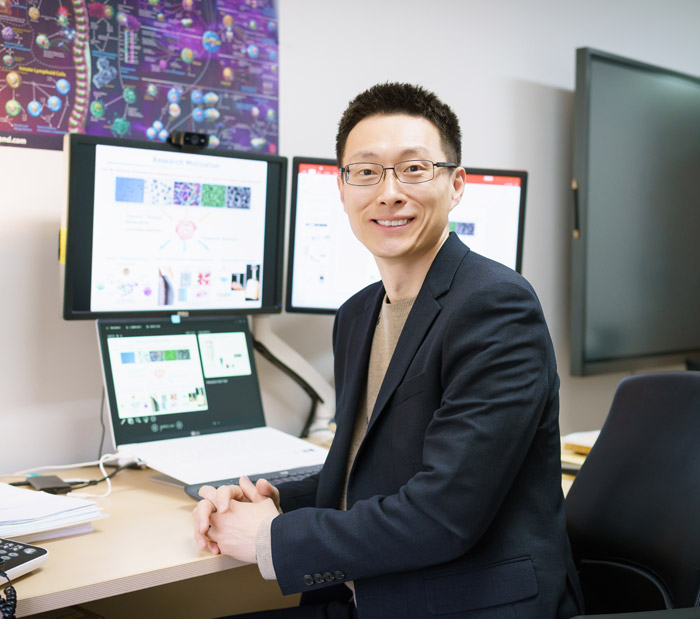
Chemical Engineering KIM, JAE YUN Prof. ·Ye Eun Kim , Dr. Seung Woo Choi
Antioxidant Hydrogel Patches for Treatment of Atopic Dermatitis
Professor Jaeyun Kim research team in the School of Chemical Engineering (The 1st coauthors: Ye Eun Kim, a graduate student, Dr. Seung Woo Choi, a postdoc) developed the antioxidant hydrogels via scavenging ROS from the inflamed skin for the treatment of atopic dermatitis (AD) without using steroid drugs. The team has previously suggested a therapeutic antioxidant contact lens for the treatment of dry eye disease. Although topical steroid drugs have been generally used for the treatment of AD, the continuous administration can cause severe side effects such as hypogenesis of children or Cushing syndrome. As AD can easily develop into chronic disease, a new treatment with high safety is highly demanded. The Therapeutic antioxidant hydrogel patches were synthesized by embedding ROS-scavenging ceria nanoparticles into biocompatible alginate hydrogels. As the increased level of ROS in AD lesions aggravates the symptoms of AD, an efficient ROS scavenging into benign water and oxygen by the antioxidant hydrogels could efficiently diminish the oxidative stress and inflammatory immune responses in AD. When the antioxidant hydrogel patches were applied onto AD induced skin of the mouse model, the level of ROS of tissue was significantly reduced. Furthermore, the epidermal thickness, the number of infiltrated inflammatory cells, and the level of inflammatory cytokines were decreased, indicating the symptoms of AD were alleviated. As hydrogel patches are soft materials, it is easily applicable to the skin. In addition, high water contents of the hydrogel are beneficial to moisturize the dried AD skin. Lastly, the embedded ceria nanoparticles were not released from hydrogels to the skin, indicating that negligible nanotoxicity in the skin would be expected. Professor Kim described that “The application of this antioxidant hydrogel patch could be expanded to diverse skin inflammatory disease and skincare which are related with a high level of ROS.” Study for therapeutic hydrogel patches for atopic dermatitis: “Therapeutic Hydrogel Patch to Treat Atopic Dermatitis by Regulating Oxidative Stress”, Nano Letters, published online (2022) Study for therapeutic contact lenses for dry eye disease: “Therapeutic Contact Lens for Scavenging Excessive Reactive Oxygen Species on Ocular Surface, ACS Nano, 14, 2483-2496 (2020) <Antioxidant Hydrogel Patch for Treatment of Atopic Dermatitis>
- No. 182
- 2022-03-29
- 2789
-
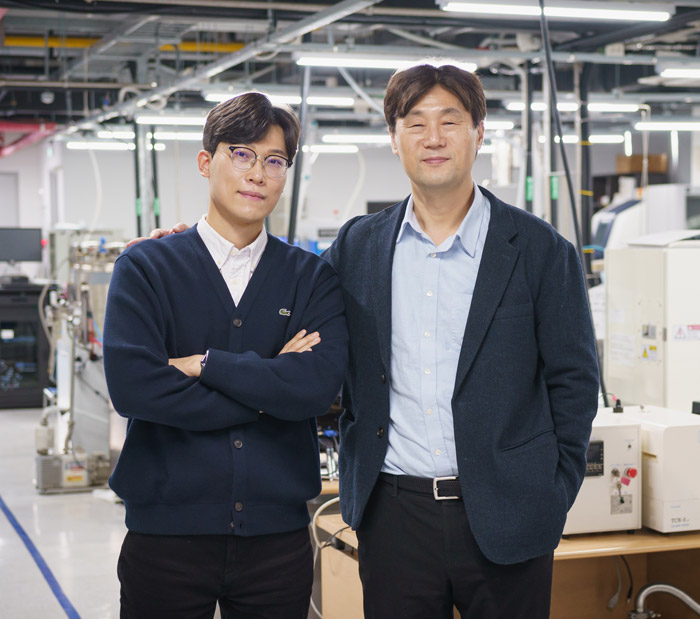
Energy Science YOON, WON SUB Prof.
Study on a High-Voltage Driven Nickel-Based Layered Cathode Material That Realizes High Energy Density
Sungkyunkwan University (President Dong Ryeol Shin) announced that the research team has found that even a low Ni content material can have high energy, a long cycle life, and thermal stability depending on the operating condition. With the declaration of carbon neutrality, the end of internal combustion engines that are based on fossil fuels is accelerating, and the era of electric vehicles is advancing. Accordingly, the high-content nickel layered cathode material attracts attention as a key material for lithium-ion secondary batteries for EVs for long-distance driving. However, as the nickel content increases, the amount of energy that can be stored increases, but due to the unique characteristics of the material that lower thermal stability, it is exposed to the risk of fire directly related to safety. A research team at Sungkyunkwan University designed a battery driving condition at a high operating voltage for low nickel content material to the same discharge capacity as a material with high nickel content, and then investigated various structural, electrochemical, and thermal stability characteristics. In this research, it was confirmed that a material having a low nickel content has low anisotropic lattice distortion in an overcharge region and a lithium ion channel through which lithium ions move is better maintained. Moreover, it was observed that a low-content nickel material in a degraded state after a long-term life evaluation has less particle grinding and less micro-cracks along with uniform chemical state distribution in particles than a high-content nickel material. In addition, through thermal decomposition mechanism analysis of materials, low-content nickel materials show better thermal stability despite higher voltage conditions than high-content nickel materials, proving a new possibility of designing lithium-ion secondary batteries with lower fire risk. Through this work, depending on the design of the battery operating conditions, the research team demonstrated that a low-content Ni-based layered cathode material with high structural, chemical, and thermal stability can be an alternative to the high-content Ni-based layered cathode material. At the same time, the research team provided a rational strategy further to expand the design elements of lithium-ion secondary batteries. Research professor Wontae Lee said, "Various energy storage materials are being researched and developed in the secondary battery field to ensure long-distance driving and safety. This research demonstrates competitive rechargeable batteries can be implemented by using existing materials through a strategic approach, leading to reconsideration of the research focus that was focused on the development of high-energy materials and provides an opportunity to diversity design factors of rechargeable batteries." This study, conducted by, Researcher Mi-hee Jeong, Research Professor Wontae Lee and Professor Won-Sub Yoon, was selected as a back cover in 'Advanced Energy Materials', a world-renowned journal in the field of material science. (2022.02.24.) [Figure 1] Comparison of crystal structure changes in accordance with lithium content of a low content and high content nickel-based layered structure material [Figure 2] Chemical state distribution in particles after initial and after 400 charge-discharge times of a low-content and high-content nickel-based layered structure material [Figure 3] Comparison of pyrolysis mechanisms of low-content and high-content nickel-based layered structures
- No. 181
- 2022-03-18
- 2265
-

Chemical Engineering KIM, JIYONG Prof. ·Do Thai Ngan, Chanhee You
Investigation of Optimal Carbon Capture and Utilization Technology for Carbon Neutralization
Carbon capture and utilization (CCU) is receiving worldwide attention due to its potential to mitigate CO2 emissions that contribute to climate changes, and the ability to produce high-value chemicals (e.g: methanol, gasoline, olefin) and fuels that lessen the burden on conventional resources. Carbon capture and utilization for energy products (CCU4E) offers several potential benefits in climate change mitigation, energy security, and sustainability. Although advances in fundamental research have shown a high potential for CCU4E framework implementation, the realistic strategies to demonstrate CCU4E in global and local applications are still unclear. For example, which pathway from CO2 capture to what mix of products through what types of conversion technologies makes CO2-based fuels economically and/or environmentally viable. Accordingly, to quicken the implementation of a competitive, practical CCU4E framework, the research team developed a system-level methodology for synthesis and evaluation of a wide range of CCU4E pathways. In this work, 72 CO2-to-fuel pathways were assessed using Process Systems Engineering (PSE)-centric techniques such as process simulation, techno-economic evaluation, environmental impact analysis, and optimization. Based on the 72 CO2-to-fuel pathways examined, the team discussed the trade-off between economic output (via unit production cost of fuels) and environmental impact (via net CO2 equivalent emissions). In addition, an optimization model was used to identify the optimal pathway and judge the decision to use conventional (black) or renewable (green) hydrogen in different scenarios. An extended sensitivity analysis was performed to understand the important role of H2 in the mitigation of CO2eq and its economic potential, globally and locally, as well as the prospect of future CO2-based fuels. This study provides practical decision-making strategies to major carbon-emitting countries to make decisions on using domestic resources to balance economy and environmental protection in the CCU4E framework. The green hydrogen price is revealed to be the key factor in future CCU4E by allowing a huge reduction in CO2eq emissions at a more stable and lower price. *Paper Title: A CO2 utilization framework for liquid fuels and chemical production: techno-economic and environmental analysis
- No. 180
- 2022-03-07
- 2805
-
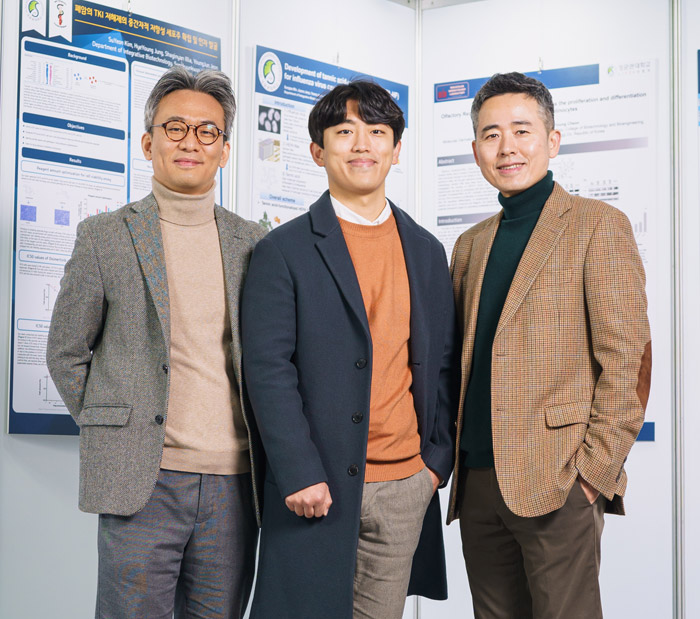
Pharmacy JO, DONG GYU Prof. ·Prof. Wonsik Lee, Dr. Hakgyun Kim
Developing a treatment that better affects the SARS-CoV-2 variants
The Sungkyunkwan university-Korea Centres for Disease Control joint research team has developed an exosome-based treatment that protects against SARS-CoV-2 infection. Through this research jointly conducted by Professor Dong-Gyu Jo and Wonsik Lee of School of Pharmacy Sungkyunkwan University, they designed exosome-based approach to deliver therapeutic proteins, confirming its potential as a protein delivery system. Since the winter of 2019, many people worldwide have been suffering from the coronavirus outbreak to this day. Although mRNA-based next-generation vaccines have been introduced, pandemics continue to occur as the effectiveness of vaccines gradually decreases due to variants that occur continuously. One of the major treatments for COVID-19 is neutralizing antibody therapy. However, these antibody therapeutics have a disadvantage in that continuously emerging variants could reduce the efficacy against the virus. The exosome-based virus neutralization strategy developed to overcome these shortcomings was designed using the binding affinity between ACE2, a cellular receptor of SARS-CoV-2, and the virus envelope protein, SPIKE protein. This strategy was based on the fact that highly infectious virus mutants increase the affinity of the SPIKE protein for ACE2. In addition, using variants of the ACE2 protein known to increase affinity for the SPIKE protein, its efficacy was further enhanced. The soluble ACE2 (sACE2) protein for virus neutralization and its variants were fused with an exosome-specific marker on the exosome surface to overcome the limited pharmacokinetics characteristics of using recombinant protein only. This method confirmed that pharmacokinetic and pharmacodynamic properties were improved while using a smaller amount of ACE2 protein than when recombinant protein was used, thereby showing excellent efficacy. ※ SPIKE protein: The envelope protein of SARS-CoV-2. It plays an essential role in host cell receptor recognition and fusion with the host cell membrane. ※ sACE2 (Soluble Angiotensin Converting Enzyme2) protein: A fragment protein that is formed by cleaving the extracellular part of this ACE2 protein. Engineered exosomes inhibit the entry of wild-type and other variants of SARS-CoV-2 pseudovirus, and protect against authentic SARS-CoV-2 and Delta variant infection. The therapeutic efficacy of the engineered exosome against SARS-CoV-2 challenge was confirmed using K18-hACE2 mice. Prof. Jo said, “We presented the new strategy engineering exosome for COVID-19 treatment agent in this study.” He said, “It will become a new driving force for the development of new therapeutics such as exosome-based COVID-19 and various diseases being developed through joint research with Exostemtech.” The National Research Foundation of Korea supported this study. This work was also supported by a grant from the Ministry of Oceans and Fisheries’ R&D project, Korea, Korea Basic Science Institute (National Research Facilities and Equipment Center) grant funded by the Ministry of Education, Korea Disease Control and Prevention Agency, and the Korea National Institute of Health fund. (Figure 1. Schematic illustration of SARS-CoV-2 infection and the application of engineered exosome for the neutralization of SARS-CoV-2.) The research results were published in the Journal of Extracellular Vesicles (IF = 25.841) online on January 4, 2022.
- No. 179
- 2022-02-18
- 2888
-
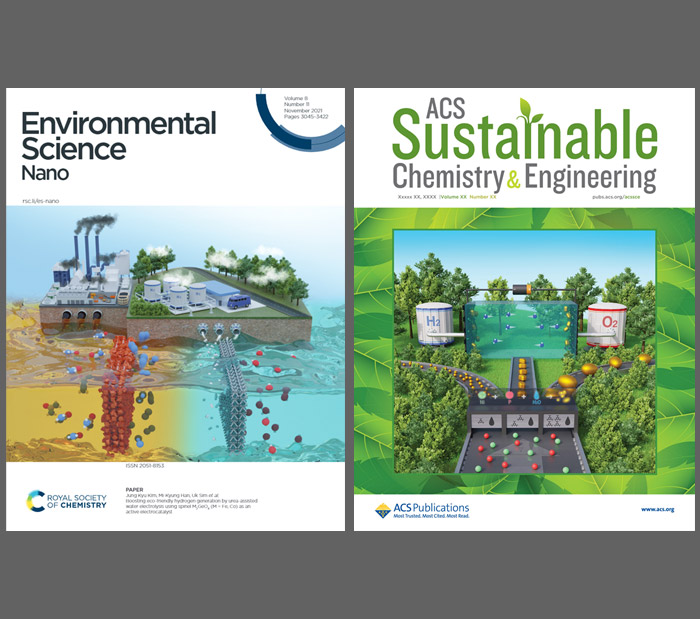
Chemical Engineering KIM, JUNG KYU Prof.
Development of environmental friendly electrocatalysts for sustainable green hydrogen production
Prof. Jung Kyu Kim (School of Chemical Engineering, SKKU) reported his collaboration research achievements with Prof. Uk Sim (Department of Materials Science & Engineering, Chonnam National University) and NILL Inc. : development of environmental friendly electrocatalysts for sustainable green hydrogen production. First, bimetallic oxides with spinel structures, M2GeO4 (M = Fe, Co), were synthesized via a facile one-pot hydrothermal method and were used as electrocatalysts for urea-assisted water electrolysis to enhance the efficiency of hydrogen production. In alkaline electrolyte with urea, Fe2GeO4, which was used as the anode in the electrolysis cell, reduced the overall input potential to produce H2. The superior performance of Fe2GeO4 in the urea-added water electrolysis was attributed to the higher oxidation state of its metal cations, larger electrochemical active surface area, and lower charge transfer resistance than those of Co2GeO4. Hence, Fe2GeO4 showed 5.49 times higher H2 peak intensity than Co2GeO4, indicating higher efficiency of H2 production. Second, single-phase metal-rich nickel phosphide (Ni12P5)-incorporated carbon composites were designed for a highly efficient water-splitting system. The distinct Ni12P5 is anchored in nitrogen (N)- and phosphorus (P)-rich carbon matrices (Ni12P5@N,P-C); the creation of the matrices entails a facile hydrothermal-followed pyrolysis treatment to explore their bifunctional activities in the water-splitting system. The Ni12P5@N,P-C composite-based two-electrode water-splitting system shows a low operating potential of 1.57 V at 10 mA cm–2 and achieves the commercially required high current density of 500 mA cm–2 at a stable potential of 2 V. The functionalization of composite electrocatalysts based on strategical engineering and the intrusion of multiple active sites can help develop enhanced electrochemical energy systems. These two research achievements were selected as the front cover art of journals ‘Environmental Science: Nano (DOI: 10.1039/D1EN00529D)’ and ‘ACS Sustainable Chemistry & Engineering (DOI: 10.1021/acssuschemeng.1c06514)’, respectively. *Paper 1: Boosting eco-friendly hydrogen generation by urea-assisted water electrolysis using M2GeO4 (M = Fe, Co) as an active electrocatalyst (저널: Environmental Science: Nano, DOI: 10.1039/D1EN00529D) *Paper 2: Anchoring of Ni12P5 Microbricks in Nitrogen- and Phosphorus-Enriched Carbon Frameworks: Engineering Bifunctional Active Sites for Efficient Water-Splitting Systems (저널: ACS Sustainable Chemistry & Engineering, DOI: 10.1021/acssuschemeng.1c06514)
- No. 178
- 2022-01-18
- 3372
-
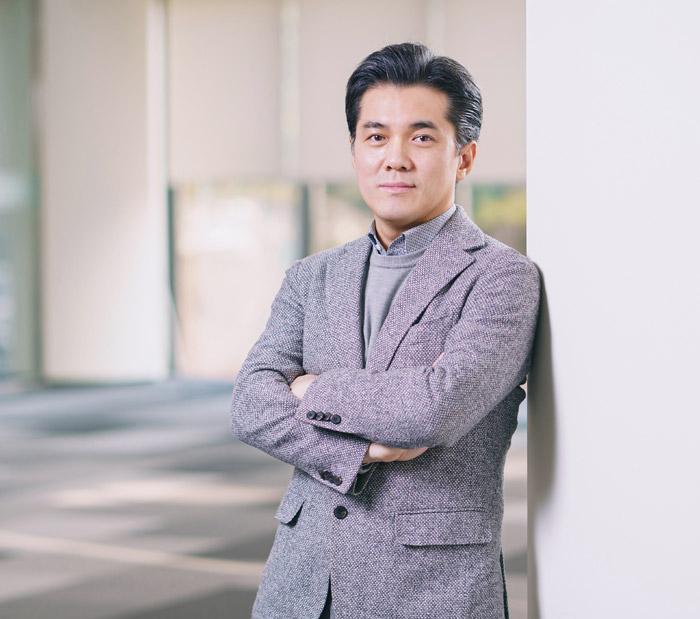
Chemical Engineering YOO, PILJIN Prof.
Unveiling the impact of Fe incorporation on intrinsic performance of reconstructed water oxidation electrocatalyst
Professor Pil Jin Yoo’s group (with Drs. Clament Sagaya Selvam and Gwan Hyun Choi) at school of chemical engineering announced that highly efficient and extremely stable oxygen evolution reaction (OER) electrocatalysts have been developed for the next generation water electrolysis technology. With a successful co-working with profs. Won-Sub Yoon (Department of Energy Science) and Won Bo Lee (Seoul National University) groups, in this work, they investigated the fundamental mechanism of dynamic interactions between electrolyte and electrocatalyst surface through experimental and theoretical way. This work was published in ACS Energy Letters (Impact Factor: 23.101) featured as a cover paper. Thanks to its environmental benignity, the water electrolysis technology has received great interest both from academy and industry as a promising solution for producing clean hydrogen energy. During the electrolysis of water into hydrogen and oxygen gases, while the reaction side for the hydrogen evolution reaction proceeds in a relatively smooth and stable way, the concurrently occurring OER reaction generally suffers from high overpotential and degradation of electrocatalysts, hindering the practical and commercial utilization of the water electrolysis to the market. To challenge this issue, the SKKU research team first proposed the nanostructured cobalt-sulfur hybrids (Co9S8) as a basic electro-conductive platform for high performance OER and subsequently electro-deposited a thin layer of nickel oxyhydroxide (NiOOH) over the surface of Co9S8 to simultaneously impart the erosion stability and electrochemical activity. In addition, for the first time, they elucidated that the enhanced electrocatalytic performance was originated from the self-Fe-doping of the catalyst surface as a result of dynamic interactions with the electrolyte. With regard to this technological advance, prof. Yoo commented that “This approach would offer a new design toolkit for high performance OER electrocatalysts and it is greatly anticipated for being extensively utilized for materials in eco-friendly energy technology”. Prof. Yoo group has also reported leading-edge research result on novel electrocatalysts in Energy & Environmental Science (Impact Factor: 38.532) in May. This work was published on December 10th in ACS Energy Letters (Impact Factor: 23.101) as a cover paper with the governmental funding support of NRF 2018M3D1A1058624, 2020R1A2B5B02002483, and 2021R1A4A1024129. ※ Paper 1 : “Unveiling the Impact of Fe Incorporation on Intrinsic Performance of Reconstructed Water Oxidation Electrocatalyst”, ACS Energy Letters, 6, 4345−4354 (2021). * Paper 2 : “Modularly aromatic-knit graphitizable phenolic network as a tailored platform for electrochemical applications”, Energy & Environmental Science, 14, 3203–3215 (2021).
- No. 177
- 2022-01-06
- 3269
-
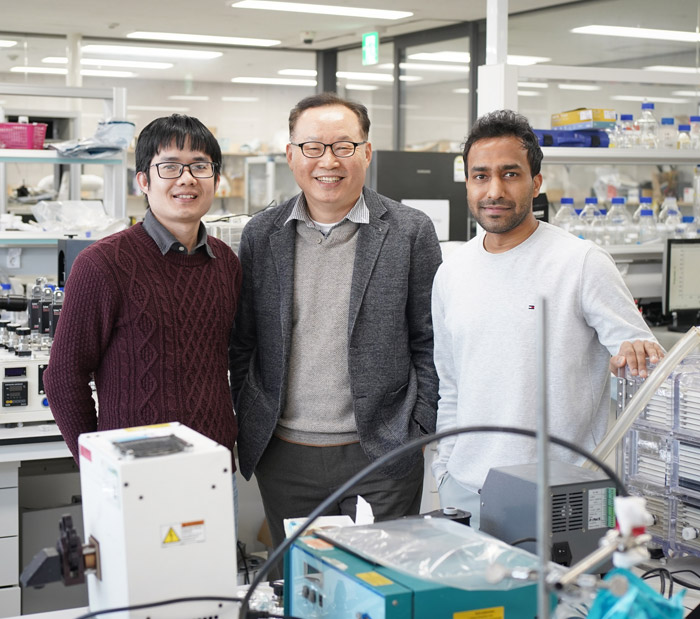
Chemistry LEE, HYOYOUNG Prof. ·Dr. Viet Quoc Bui , Ashwani Kumar
Single-Atom Dimer Electrocatalyst for Green Hydrogen Production
Green hydrogen generated from the electrolysis of water using renewable electricity is considered a next-generation renewable energy source for the future and a possible alternative to fossils fuels. But in reality, the overwhelming majority of hydrogen fuel is obtained from the refining of fossils fuels due to the high cost of electrolysis. Currently, the efficiency of water electrolysis is limited and often requires high cell voltage due to the lack of efficient electrocatalysts for hydrogen evolution reactions. Noble metals such as platinum (Pt) are used as catalysts to improve hydrogen generation in both acidic/alkaline media. However, these noble metal catalysts are very expensive and show poor stability under long-term operation. Recently, single-atom catalysts have shown excellent activity compared to their nanomaterial-based counterparts. This is because they are able to achieve up to 100% atom utilization, whereas in nanoparticles only the surface atoms are available for reaction. However, due to the simplicity of the single-metal-atom center, carrying out further modification of the catalysts to perform complex multistep reactions is rather difficult. The simplest way to modify the single atoms is by turning them into single-atom dimers sites, which combine two different single atoms together. Tuning the active site of single-atom catalysts with dimers can improve the reaction kinetics thanks to the synergistic effect between two different atoms. However, while the synthesis and identification of the single-atom dimer structure have been known conceptually, its practical realization has been very difficult. This problem was tackled by a research team led by Associate Director LEE Hyoyoung of the Center for Integrated Nanostructure Physics within the Institute for Basic Science (IBS) located at Sungkyunkwan University. The IBS research team successfully developed atomically dispersed Ni-Co dimer structure stabilized on nitrogen-doped carbon support, which was named NiCo-SAD-NC. “We synthesized Ni-Co single atom dimer structure on nitrogen (N)-doped carbon support via in-situ trapping of Ni/Co ions into the polydopamine sphere, followed by pyrolysis with precisely controlled N-coordination. We employed state-of-the-art transmission electron microscopy and x-ray absorption spectroscopy to successfully identify these NiCo-SAD sites with atomic precision,” says Ashwani Kumar, the first author of the study. The researchers found that annealing for two hours at 800°C in an argon atmosphere was the best condition for obtaining the dimer structure. The research team evaluated the catalytic efficiency of this new system in terms of the overpotential required to drive the hydrogen evolution reaction. The NiCo-SAD-NC electrocatalyst had a comparable level of overvoltage as commercial Pt-based catalysts in acidic and alkaline media. NiCo-SAD-NC also exhibited 8 times higher activity than Ni/Co single-atom catalysts and heterogenous NiCo nanoparticles in alkaline media. At the same time, it achieved 17 and 11 times higher activity than Co and Ni single-atom catalysts, respectively, and 13 times higher than conventional Ni/Co nanoparticles in acidic media. In addition, the researchers demonstrated the long-term stability of the new catalyst, which was able to drive reaction for 50 hours without any change of structure. The NiCo-SAD exhibited superior water dissociation and optimal proton adsorption compared to other single-atom dimers and Ni/Co single-atom sites, boosting pH-universal catalyst’s activity based on the density functional theory simulation. ▲ Figure 1. Representation models of a) nickel single-atom, b) cobalt single-atom, c) nickel-cobalt single-atom dimer (NiCO-SAD-NC), and d) nickel-cobalt heterogenous nanoparticle catalysts. ▲ Figure 2. The schematic diagram of the hydrogen evolution reaction (HER) process using NiCo-SAD stabilized on N-doped carbon (left). HER activity in alkaline (top right) and acidic media (bottom right). “We were very excited to discover that the novel NiCo-SAD structure dissociates water molecules with a much lower energy barrier and accelerates hydrogen evolution reaction in both alkaline and acidic media with performances comparable to that of Pt, which addressed the shortcomings of the individual Ni and Co single-atom catalysts. The synthesis of such single atom dimer structure was a long-standing challenge in the field of single-atom catalysts,” notes Associate Director Lee, the corresponding author of the study. He further explains, “This study takes us a step closer to a carbon-free and green hydrogen economy. This highly efficient and inexpensive hydrogen generation electrocatalyst will help us overcome long-term challenges of cost-competitive green hydrogen production: to produce high-purity hydrogen for commercial applications at a low price and in an eco-friendly manner.” The study was published in Nature Communications (IF 14.92), a world-renowned journal in the field of basic science. ※Title of Paper: Moving Beyond Bimetallic-Alloy to Single-Atom Dimer Atomic-Interface for All-pH Hydrogen Evolution
- No. 176
- 2021-12-21
- 3713
-
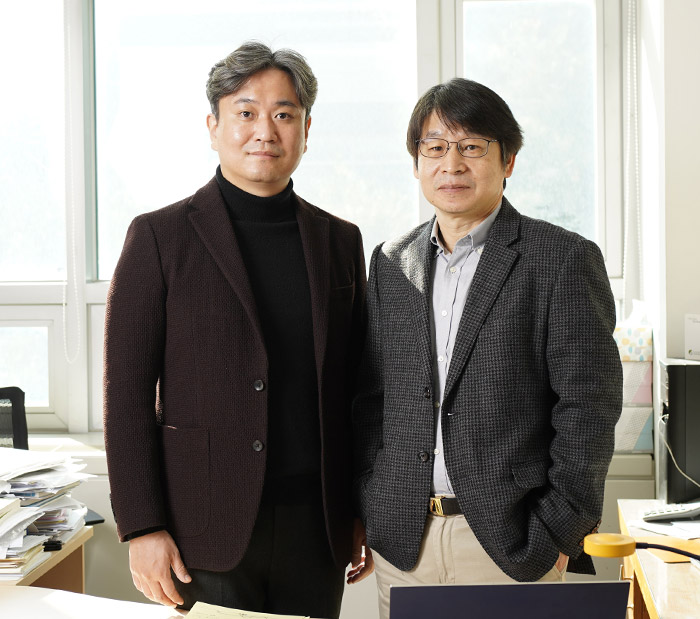
SKKU Advanced Institute of Nano Technology BAE, WANKI Prof. ·Prof. Euyheon Hwang
Presents an approach to a control by steering dipole densities at the interface of III-V–II-VI h-NCs
Heterostructured nanocrystals (h-NCs), in which multiple nanoscale semiconductor domains are interconnected via bonding interfaces, are new classes of luminophores that stand at the forefront of nearly all light-emitting applications. The success of h-NCs is attributed to the controllability and the tunability of the electronic structure and the spatial distribution of charge carriers in h-NCs. Such changes are emergent collective responses to the dimension and the composition of h-NCs, which define the potential profile at the interface of h-NCs and consequently the photophysical and photochemical characteristics of h-NCs. Everyday light-emitting applications call for the research to understand and manipulate heavy metal-free h-NCs, which are formulated with the combinations of III-V and II-VI compounds (e.g., InP/ZnSe or ZnS h-NCs). However, the limited material choice for III-V/II-VI h-NCs deters the access to one of the external knobs for the control of the potential landscape of h-NCs. The quantum confinement effect allows marginal success in controlling the optical bandgap of III-V/II-VI h-NCs, but the customized potential profile has considered to be unavailable. This constrains the envelopment of materials functions including the recombination dynamics and transport characteristics of charge carriers that are keys to the success of optical and optoelectronic applications implementing h-NCs. In the present study, the team of Prof. Wan Ki Bae and Prof. Euyheon Hwang of SKKU advanced institute for Nanotechnology (SAINT) provide an unprecedented approach to tailor the potential landscape of heavy metal-free III-V/II-VI h-NCs on demand. The present research stems from our discovery that the heterovalent bonding at the interface, which exists inevitably in the formation of III-V/II-VI interfaces, is an additional knob that changes the potential profile of III-V/II-VI h-NCs. Spectroscopic analysis in chorus with quantum mechanical calculation and density functional theory calculation show that the interfacial polarization by the heterovalency at the interface is responsible for the vacuum level shift that alters the potential profile across III-V/II-VI h-NCs. In addition to the findings, the team devise an effective chemical means to control the stoichiometry at the III-V/II-VI interfaces with atomic precision. The interfacial dipole intensity enables to adjust the band positions of III-V cores on demand by an extent of ca. 400 meV at the given geometry of InP/ZnSe h-NCs, which accompanies the changes in their electronic energy levels, the spatial distribution of charge carriers and their recombination dynamics, and the transport characteristics of charge carriers across h-NCs. A comprehensive study on III-V/II-VI h-NCs of varying compositional combinations (i.e., InP/ZnSe, InP/ZnS, InAs/ZnSe, In0.5Ga0.5P/ZnSe, In0.3Ga0.7P/ZnS, and InP/CdS h-NCs) is conducted to comprehend the structural-property relationship quantitatively and to validate the impact experimentally. Furthermore, the team capitalize on the atomic precision with which to synthesize h-NCs by correlating interfacial dipole moments to photochemical stability and optoelectronic performance of resulting h-NCs. The customized potential profile in h-NCs promises to engineer the transport characteristics of charge carriers across h-NCs to environments, enabling us to enhance the photochemical stability of h-NCs against the external stress and the optoelectronic performance of h-NCs in light-emitting diodes close to the theoretical limit (EQE ~ 18.5 %). The present study implies that, together with the quantum confinement effect, the capability of engineering the structural characteristics of the heterovalent interface allows one to customize the potential profile of heavy metal-free III-V/II-VI h-NCs that overcome the limitation of materials choice, and hence fosters the practical use of h-NCs in a variety of light-emitting applications. This work was supported by the National Research Foundation of Korea (NRF) grant funded by the Ministry of Science, ICT, and Future Planning (2020R1A2C2011478, 2021M3H4A3A01062964, 2020M3D1A2101319, and 2021M3H4A1A01004332), and Electronics and Telecommunications Research Institute (ETRI) grant funded by the Korean government (No. 20ZB1200, Development of ICT Materials, Components and Equipment Technologies). This research was also supported by Samsung Display. ※Title: Interface polarization in heterovalent core/shell nanocrystals
- No. 175
- 2021-12-06
- 2898
